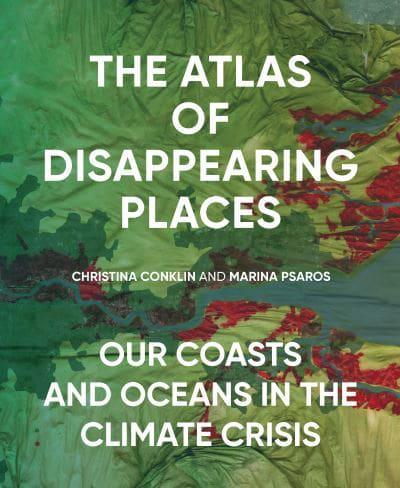 © Christina Conklin and Marina Psaros. This excerpt originally appeared in The Atlas of Disappearing Places: Our Coasts and Oceans in the Climate Crisis, published by The New Press. Reprinted here with permission.
© Christina Conklin and Marina Psaros. This excerpt originally appeared in The Atlas of Disappearing Places: Our Coasts and Oceans in the Climate Crisis, published by The New Press. Reprinted here with permission.
The Thames Estuary: From Gravesend to Allhallows
On June 25, 2019, six-year-old Leo Mansten stood before the Gravesham Borough Council, one of the local governments on the eastern edge of London, to ask a question. “The planet is getting hotter,” he said. “People are dying. Would you consider having a selection of children and young people on the council to help make decisions about climate change? It will affect us the most.” Leo’s mother, Laura, had not been particularly active in local politics until she attended the million-strong Extinction Rebellion march in London in April 2019. She was so disturbed to learn how urgent the situation is that she decided to get involved in the move to get local government councils to declare a climate emergency, and Leo had wanted to come along. That night, the Gravesham Council demurred on youth enfranchisement but voted in favor of the declaration, as Parliament had done unanimously a few months before. Yet the gap between such easy gestures and the U.K. government’s actual policies and spending priorities remains as wide as the expansive tidal sands of the Outer Thames River estuary.
The Thames winds its way from Gloucestershire toward the English Channel, its last 104 kilometers (65 miles) running through central and east London, and then past industrial and rural landscapes, to the sea. Protecting central London from storm surge and sea-level rise is the Thames Barrier, which was completed in 1983 in response to the deadly flood of 1953 and lies just east of the City of London financial district. Tides in the Thames can rise and fall seven meters (twenty-three feet) in a day, with low tides exposing stony beaches and high tides lapping at the top of London’s river walls. Over nearly forty years, the barrier has been closed 193 times (as of September 2020), saving London from many catastrophic floods.
East of the barrier, however, there are few protections from the sea, where more than 1.5 million people live on land lined by seawalls and dikes. The boroughs of Newham and Greenwich, which lie on either side of the barrier, are at greatest risk of severe inundation; parts of London’s Royal Docks neighborhood will be below the tide line when seas rise one meter. This inner estuary includes many of London’s edgelands, places where London has sent its sewage and garbage for centuries, creating a topography of low, rolling hills where there were once only marshes. The Barking sewage works lies adjacent to the River Roding, a Thames tributary, and just upstream from the Rainham Marshes and Landfill. Across the river, Thamesmead, a town built on infill, is already two to three meters below sea level at the highest tides. Here flood depths in a surge could exceed five meters.
The outer estuary, though it is just a few kilometers farther downstream, is a landscape Charles Dickens called “the dark flat wilderness . . . intersected with dikes and mounds and gates,” the Thames a “low leaden line beyond.” This foggy expanse of tidal mudflats and shining sands is interrupted only by the odd cargo ship, oil terminal, and gas storage facility. Few towns dot the shore, except at higher promontories like Gravesend and poorly sited holiday villages like Allhallows-on-Sea. Though the government no longer parks prison ships in the mud for men to languish and die in, as in Victorian times, as oceans rise, these current and former marshlands could one day regain their earlier reputation as breeding grounds for waterborne disease, including cholera, typhoid, and malaria, which Dickens refers to as “the ague.”
The British love a good plan, so in 2012 the government’s Environment Agency published Thames Estuary 2100, which provides guidance to other agencies and local governments on regional priorities. The plan acknowledges that twenty to ninety centimeters (eight to thirty-five inches) of sea-level rise is all but inevitable by the end of this century. It focuses on developing the estuary by converting its rundown communities, low-value lands, and industrial estates into high-density hubs of commuter commerce. But it does not require this new development to be on higher ground or even slightly removed from the river’s edge. Brand-new malls and luxury high-rises already abut the river in towns like Erith and Greenhithe. Yet despite its important implications, TE 2100 received little attention upon its release and remains all but unknown today outside planning circles. Though it primarily assesses flood risk, this report also creates a de facto plan for sea-level rise management in the region—which is to hold the current shoreline against the rising tide, whatever it takes.
TE 2100 was reaffirmed as written in 2016, despite rapidly improving science and worsening sea-level rise projections. Its restated goal is to maintain and improve the existing national system of dikes, flood gates, and barriers “as the optimum approach for the first 60 years of our Plan, with new arrangements required by 2070.” The only evaluation process is a decadal review of the science and a grand review of the plan in 2050. The government is not requiring more frequent updates or opportunities for public scrutiny because so few citizens have demanded it.
Developers have taken note, though.
The updated London Plan, being finalized in 2020, is rife with mentions of “opportunity areas” east of the city, but it relies on the TE 2100 data to “ensure that London is protected until the end of the century.” Another report, this from the Thames Estuary Growth Commission, envisions filling in all the estuary’s existing gaps with roads and bridges, flats and shops, businesses, industries, and universities to orbit around London, resulting in 1.3 million new jobs and 4.3 million people by 2035, triple today’s population. No one is talking about where and how all of those jobs and people will be moved once the water comes.
The difficult truth is that not every shoreline community will come out on the winning end of the U.K. government’s cost-benefit analysis, and many places will have to be abandoned. Those that are chosen for defense will become fortress-cities that sop up most of the budget in their struggle for survival, while others will languish, underserved. A different approach would acknowledge that sea levels around Britain will continue to rise for centuries and will erase many of today’s hard lines between land and sea. It would return large areas to the tide and create or reestablish so infrastructure like marshes, sand barrier islands, beaches, and mudflats in as many places as possible. Instead of inviting millions into the path of the water, it would prepare for the gradual, rational relocation of millions to higher ground.





